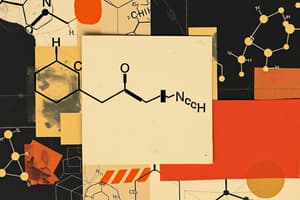Podcast
Questions and Answers
What defines a substance to be classified as a flammable solid?
What defines a substance to be classified as a flammable solid?
- It must be a liquid at room temperature.
- It ignites easily and continues to burn after the ignition source is removed. (correct)
- It can only ignite in the presence of a strong oxidizer.
- It must combust only after prolonged exposure to heat.
Which of the following is an example of spontaneously combustible solids?
Which of the following is an example of spontaneously combustible solids?
- Magnesium
- Camphor
- White phosphorus (correct)
- Nitrocellulose
How do oxidising substances contribute to combustion?
How do oxidising substances contribute to combustion?
- They provide oxygen that facilitates the burning of other substances. (correct)
- They generate intense heat without any chemical reaction.
- They are combustible by themselves.
- They absorb oxygen to reduce combustion rates.
Which option does NOT fit the category of flammable solids?
Which option does NOT fit the category of flammable solids?
What reaction occurs when organic peroxides decompose?
What reaction occurs when organic peroxides decompose?
Which of the following is NOT classified as an oxidising substance?
Which of the following is NOT classified as an oxidising substance?
What is the primary characteristic of flammable solids?
What is the primary characteristic of flammable solids?
Which of these substances is a common example of a flammable solid?
Which of these substances is a common example of a flammable solid?
What can prolonged exposure to hydrocarbons result in?
What can prolonged exposure to hydrocarbons result in?
What is a potential hazard of chlorinated hydrocarbons like chloroform?
What is a potential hazard of chlorinated hydrocarbons like chloroform?
What is the immediate effect of chemical accidents on the human body referred to as?
What is the immediate effect of chemical accidents on the human body referred to as?
How can ventilation in a lab affect prolonged exposure to hazardous substances?
How can ventilation in a lab affect prolonged exposure to hazardous substances?
What can extensive handling or inhalation of mercury vapors cause?
What can extensive handling or inhalation of mercury vapors cause?
What is a key strategy to minimize risks when performing reactions that produce harmful gases?
What is a key strategy to minimize risks when performing reactions that produce harmful gases?
What initial symptoms are associated with alcohol ingestion?
What initial symptoms are associated with alcohol ingestion?
What can be a result of poor lab practice or unsafe work systems over time?
What can be a result of poor lab practice or unsafe work systems over time?
What is considered a hazardous chemical?
What is considered a hazardous chemical?
What is the purpose of a fume cupboard in a laboratory?
What is the purpose of a fume cupboard in a laboratory?
At what temperature is a liquid defined as a flammable liquid?
At what temperature is a liquid defined as a flammable liquid?
Which of these is NOT a personal protective device mentioned?
Which of these is NOT a personal protective device mentioned?
What risk does the random storage of chemicals in the lab pose?
What risk does the random storage of chemicals in the lab pose?
What information does a chemical label provide?
What information does a chemical label provide?
How are chemicals in containers larger than 500 cm3 categorized?
How are chemicals in containers larger than 500 cm3 categorized?
What is the recommended practice regarding personal protective devices in the laboratory?
What is the recommended practice regarding personal protective devices in the laboratory?
What is the aim of handling chemicals safely in a laboratory?
What is the aim of handling chemicals safely in a laboratory?
Which of the following substances is classified as a flammable liquid?
Which of the following substances is classified as a flammable liquid?
What does acute exposure to chemicals typically result in?
What does acute exposure to chemicals typically result in?
Which of the following is NOT an appropriate personal protective device in a laboratory?
Which of the following is NOT an appropriate personal protective device in a laboratory?
Which hazard classification involves substances that can spontaneously ignite?
Which hazard classification involves substances that can spontaneously ignite?
What is the primary purpose of a fume cupboard in the laboratory?
What is the primary purpose of a fume cupboard in the laboratory?
What type of sampling involves taking a small amount of a substance for testing?
What type of sampling involves taking a small amount of a substance for testing?
Which of the following is classified as a carcinogen?
Which of the following is classified as a carcinogen?
What is one of the primary hazards associated with cyanides in the laboratory?
What is one of the primary hazards associated with cyanides in the laboratory?
Which of the following properties is crucial for characterizing an adsorbent?
Which of the following properties is crucial for characterizing an adsorbent?
Which of the following describes chronic exposure to hazardous chemicals?
Which of the following describes chronic exposure to hazardous chemicals?
What type of chemicals would be categorized as oxidizing agents?
What type of chemicals would be categorized as oxidizing agents?
Which element is commonly associated with acute poisoning in chemical laboratories?
Which element is commonly associated with acute poisoning in chemical laboratories?
What is a major risk of using incompatible chemicals together?
What is a major risk of using incompatible chemicals together?
What is the key focus of a laboratory safety code of practice?
What is the key focus of a laboratory safety code of practice?
Which of the following is considered an oxidizing agent?
Which of the following is considered an oxidizing agent?
What is a key characteristic of dangerous substances when wet?
What is a key characteristic of dangerous substances when wet?
Which of the following substances is classified as a toxic substance?
Which of the following substances is classified as a toxic substance?
What distinguishes biohazardous substances from other toxic substances?
What distinguishes biohazardous substances from other toxic substances?
Which of the following represents a property of infectious substances affecting humans?
Which of the following represents a property of infectious substances affecting humans?
What is a common example of an organic peroxide?
What is a common example of an organic peroxide?
Which of the following substances is an example of an infectious substance affecting animals?
Which of the following substances is an example of an infectious substance affecting animals?
What is the primary risk of substances classified as Class-6 poisonous and infectious substances?
What is the primary risk of substances classified as Class-6 poisonous and infectious substances?
Flashcards are hidden until you start studying
Study Notes
Hydrocarbons and Mercury Toxicity
- Inhalation of hydrocarbons leads to irritation and tissue destruction.
- Prolonged exposure to hydrocarbons can be dangerous; some may be carcinogenic.
- Chlorinated hydrocarbons, such as chloroform, can produce toxic phosgene gas.
- Mercury is highly toxic; inhalation or extensive handling may cause tissue poisoning.
- Long-term exposure to mercury exacerbates its toxic effects.
Acute and Chronic Effects of Chemical Exposures
- Acute effects are immediate and identifiable, often resulting from chemical accidents.
- Chronic effects may emerge gradually, making them hard to trace initially.
- Alcohol consumption illustrated:
- Acute effect: drunkenness and vomiting.
- Chronic effect: addiction, liver damage.
- Safe lab practices, like morning ventilation, minimize both acute and chronic effects.
Fume Cupboard Usage
- Harmful reactions producing gases or dusts must be conducted in a fume cupboard to prevent inhalation risks.
- Fume cupboards include air extraction systems to vent harmful vapors.
- They provide access to essential utilities like gas, water, and electricity.
Classification of Flammable Solids
- Flammable solids ignite easily upon contact with ignition sources and continue burning.
- Examples include camphor, hay, phosphorus, and sodium sulfide.
- Subcategories:
- Flammable solids (e.g., nitrocellulose).
- Spontaneously combustible solids (e.g., white phosphorus).
Class 5: Oxidising Substances
- Oxidising substances cause exothermic reactions with flammable chemicals, enhancing combustion.
- Organic peroxides can lead to explosions under thermal decomposition.
- Examples: nitrates, permanganates, and organic peroxides like benzoyl peroxide.
Class 6: Poisonous and Infectious Substances
- Poisonous substances can cause death or serious injury through inhalation or skin contact.
- Subgroups:
- Toxic substances (e.g., potassium cyanide).
- Biohazardous substances, which can be infectious and cause severe health impacts.
Hazardous Chemicals Overview
- A hazardous chemical poses risks to humans, living creatures, and the environment.
- Proper lab practices, including using personal protective equipment (PPE), minimize the risk of injury or damage.
- Chemical bottles should be properly labeled to indicate associated risks and nature.
Laboratory Safety Practices
- Random storage of chemicals can lead to dangerous reactions; avoid incompatible contacts.
- Bulk chemicals are defined as containers over 500 cm³ in capacity.
- Implementation of safety measures in the lab prevents accidents and enhances safety.
Studying That Suits You
Use AI to generate personalized quizzes and flashcards to suit your learning preferences.




